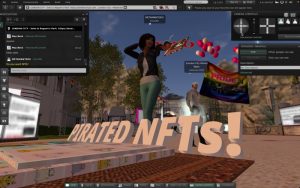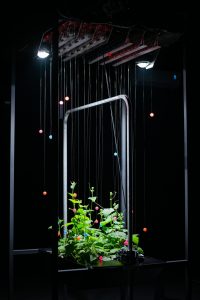Medialab Prado‘s latest Interactivos? workshop in Madrid was dedicated to Garage Science, the home laboratory-type experiments that nowadays rely on web-based communications to give rise to real and virtual communities of amateur scientists.
Interactivos?’09 aims to explore these practices, where art, science and technology meet. We invite the participants to turn Medialab into a garage laboratory where low-cost, accessible materials are used to develop objects and installations that combine software, hardware and biology. There’s license to fail!
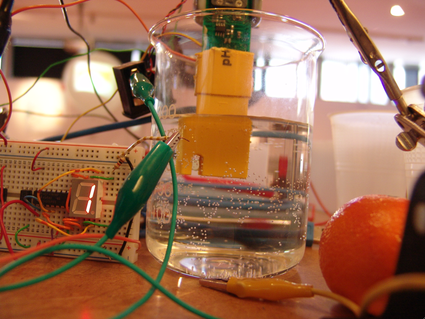
It took me longer than i wanted to get a few of the projects developed during the Interactivos? workshop online. Here’s the first one. It’s the Fruit Computer Laboratory by Alejandro Tamayo (whom i interviewed 2 years ago.)
Newspapers and magazines regularly relay the forecast that within 10 to 15 years we’ll be using “hybrid” computers running a combination of technology and living organic tissue. Alejandro Tamayo didn’t need to rely on the highest technology to investigate what an organic computer might be like. He started with the classical garage scientist knowledge that chemical reactions in fruits can produce an electrical flow if one uses appropriate electrodes. Fruit electricity has been harnessed for turning on LEDs and powering small electronic devices.
But, could chemical reactions in fruits be also used to create on-off switches, the basic building blocks of computer logic and memory? Would it be possible to create a computer with fruits? This project proposes to create a temporary laboratory, open to the general public, that will raise questions and reflections about the construction of a future computer based on fruits.
You wrote in the presentation of the project, that the Fruit Computer Laboratory would be open to practical accidents, unexpected directions and serendipity. Did that happen as much as you expected? Did it help the development of the project?
Definitely, starting with the proposal to use the pH levels of fruits. That was something I have never considered myself and it took over the whole direction of the project. In terms of accidents I wish we had had time to make more. One day we proposed to work all with our less used hand in order to see what kinds of new mistakes we could have made, but it was almost the last day and we were too busy preparing the final presentation that it never happened, but this is something I really want to try.
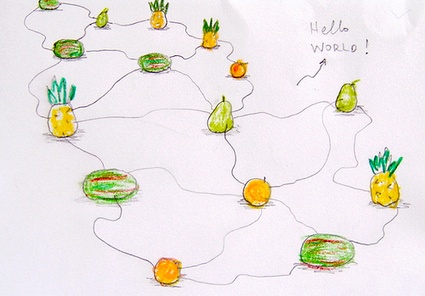 What was the biggest challenge you met with when developing the project and how did you overcome it?
What was the biggest challenge you met with when developing the project and how did you overcome it?
The biggest challenge while working on the organic memory was to find a way to get information out from the pH meter without affecting the measurement at the same time. This is something that we haven’t fully resolved yet.
Making an organic logic gate that would work with pH changes (the second part of the project) is a huge challenge itself and we are only starting to explore this path. We had the chance to talked with great people (Adrian Bowyer, Marc Dusseiller to mention only a few) who gave us ideas for this like using pH sensitive gels. We got some chemicals to start playing with them but we haven’t get very far in this respect yet.
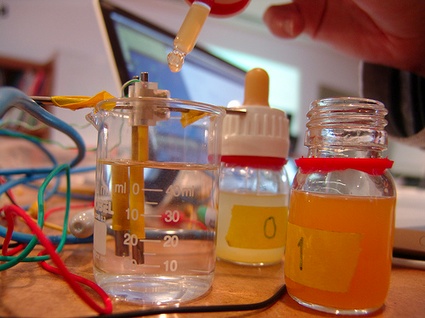 I left Madrid when you still had to give the finishing touch to the project. What does the final computer look like? How does it look?
I left Madrid when you still had to give the finishing touch to the project. What does the final computer look like? How does it look?
At this moment the use of pH levels of fruits for storing binary information has proved to be effective, allowing to program a bit of memory many times. This is how it works:
We have selected two fruits with close pH levels (lemon and mandarin). This selection has been made to facilitate the programming and reprogramming of the organic memory by adding a few number of juice drops. Measurements located in the lemon pH range (2.5 – 2.0) are considered as logic zero, whereas measurements located in the pH range of mandarins (3.0 – 3.8) are considered as logic one. These measurements are currently obtained with the use of a commercial pH meter.
By adding drops of one juice or another it is possible to program the bit of memory as many times as desired (or at least, until the recipient is full).

At the moment one bit of memory looks like this:
The pH meter gets the pH value from the solution and shows “0” or “1” in the display according to the measurement. We are working the way to extract the information from the pH meter without considerably affecting the value so the measurement gets more accurate.
Do you intend to push the project any further?
We would love to build an organic memory composed of at least 88 bits. With this size we could store an 11 character word or sentence (if we were to use ASCII code). Just enough to store the traditional “hello world message” and observe how it could change in time (or not) according to the natural processes of degradation.
But pH sensors are fairly expensive, so we have been experimenting with alternative ways to make them. Recently, Renato Ianhez from Brazil wrote us suggesting a method for making them using Christmas-tree ornamental balls. We are looking forward to start experimenting in this direction, although finding Christmas-tree ornamental balls in mid march has been a funny challenge.
Thanks Alejandro!
All images courtesy Alejandro Tamayo.

